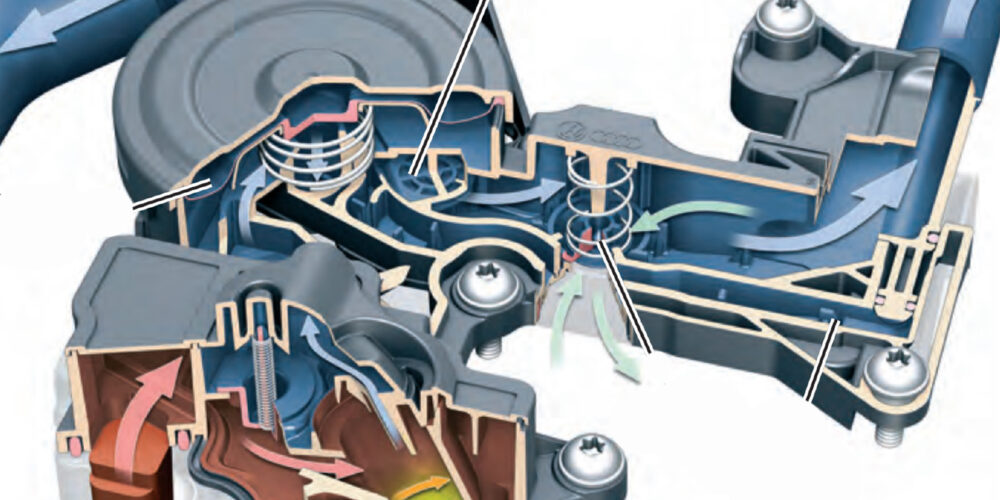This Tech Tip is intended to cover VW models that use the TPMS system Without Wheel Position Recognition.
These vehicles use the Direct TPMS system with Address [65] – Tire Pressure Monitoring control module.
The Comfort System control module antenna is used to receive the signals from four wheel-mounted TPMS sensors. For this reason, the wheel position recognition is not possible.
This system is commonly found in the U.S. spec:
▪2005 and newer Golf, GTI, Rabbit, Jetta, Jetta Sportwagen (1K/5M)
▪2010 Golf/Golf Plus/Jetta Wagon (JSW)/Golf Variant (5K/52/AJ)
▪2010 only Jetta (1K/AJ)
▪2007 and newer Eos (1F)
▪2006 and newer Passat (3C)
▪2009 and newer Passat Coupe (35) and Tiguan (5N)
Some of the 2011 and newer NAR (North American Region) Golf platform vehicles have switched to the Indirect TPMS system. Those vehicles use the ABS Brake Electronics (MK60EC1) system and Address [65] – Tire Pressure Monitoring is not used. This procedure does not apply and the vehicle is equipped with a reset button, the owner’s manual and labels on the chassis will include vehicle-specific instructions for the learning drive and reset.
Special Tools
VCDS (VAG-COM Diagnostic System)
▪Battery Charger
▪Tire Psi Gauge
▪Air Compressor
Prerequisites
▪> Check the actual tire pressures. If a leak is found correct it first!
▪> When checking the tire pressure, verify that metal valve stems are present. Rubber valve stems are a good indication that TPMS sensors are not installed.
Procedure with VCDS
▪1. Select control module address [65-Tire Pressure] and check the [02-Fault Codes]. Leave the key on.
▪2. If no fault codes are stored and the TPMS light is on, the solution may involve correcting the low tire psi.
Confirm this by taking the vehicle for a short test drive or performing the wake-up procedure; the light should go out.
▪3. If faults are stored, further diagnosis is necessary.
The Wake-Up Procedure
▪With the key on, rapidly deflate all four tires, one at a time, by approximately 10 to 12 psi. This is critical because the sensors will awaken when a rapid psi loss is detected.
Alternatively, a hand-held TPMS tool can be used to wake the sensors without letting air out of the tires.
Note: It may take between 15 seconds and 2 minutes for the data to be transmitted to the module.
1. Check [08-Measuring Blocks]. The relevant sensor readings are generally:
▪> MBs 001, 004, 007 and 010, should show the wheel-specific data including Actual and Specified readings.
▪> MB 016 can be very useful since it contains the data from the last sensor to transmit a signal.
▪> MB 025 will show which wheel set is enabled. Wheel set 1 is default. If it’s on wheel set 2, Adaptation values may need to be altered.
▪2. Move onto each wheel to verify the readings.
▪3. Correct all tire psi to the specified level for the vehicle. If one or more wheels are not showing an Actual reading it will be necessary to determine which sensor is at fault.
▪If a sensor is suspected to be faulty it would be advised to log the Good wheel and the Suspect wheel during a test drive. This will confirm that no reading is shown while driving when centrifugal acceleration and vehicle speed are present.
Matching a New Sensor
If a new sensor was installed it must be matched to the module.
▪1. Turn the key on with a battery charger connected.
▪2. Awaken all sensors as previously described immediately followed by correcting the tire psi.
▪3. Leave the key on for an additional 20 minutes and do not move the vehicle. This will allow the module to learn the ID from the new sensor.
▪4. After the learning procedure has been performed, take the vehicle for a test drive. The length of the drive may vary depending on the vehicle but 5 to 8 minutes is typically sufficient.
Special Notes
▪> Depending on ambient temperatures, a psi loss greater than 2 psi can cause a warning lamp to
illuminate without storing fault codes.
▪> Always refer to the tire psi shown in the driver’s door label for the specifications for each vehicle.
▪> The TPMS module will not display Actual psi data after the key has been cycled. The wake-up procedure or a test drive will need to be repeated after a key cycle.
▪> An inactive wheel sensor will not transmit a signal to the module.
▪> When replacing a sensor it is generally useful to take note of the new ID, printed on the body of the part, prior to the tire being mounted on the wheel.
▪> By design, the TPMS system will not alert the driver for an overinflated tire, only under-inflation conditions will trigger a fault lamp!
> TPMS battery life is estimated by the control module and may not display information in the measuring block groups until the vehicle is driven.
Courtesy of Ross-Tech.










